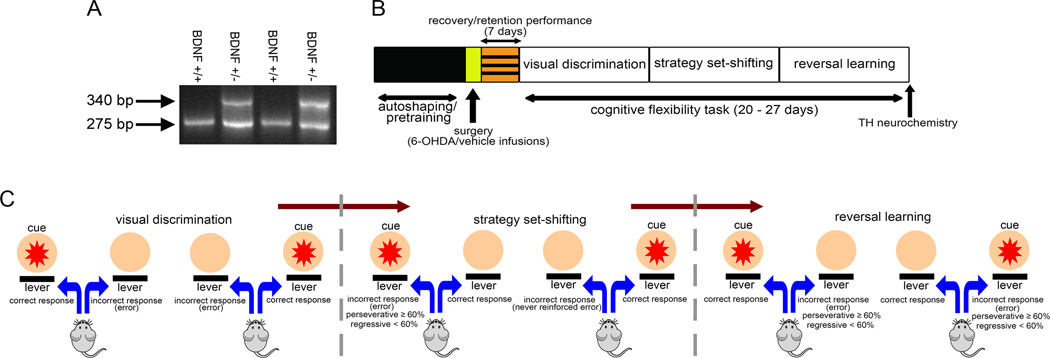Figure 1.
Genotyping and experimental design. (A) PCR-based genotyping revealed two gene products in BDNF+/− mice (275 and 340 bp, respectively) as compared to the single product of 275 bp in WT mice. (B) Schematics of the experimental design. BDNF+/+ and BDNF+/− mice were initially autoshaped and then pretrained to press an activated lever within allotted time to receive reinforcement. Animals that reached pretraining criterion received bilateral infusions of either 6-OHDA or vehicle into the dorsal striatum (see Methods). Following recovery, mice were trained to retain pretraining criterion. Mice remained at pretraining phase for an additional 7 days following which they progressed to subsequent stages of the task, i.e. visual discrimination, strategy set-shifting and reversal learning. The total number of days required to complete behavioral testing for all three phases of the task varied between 20–27 days across all animals. After completion of behavioral testing, the brains of the animals were removed and examined for striatal tyrosine hydroxylase (TH) protein expression either via quantitative immunohistochemistry or immunoblotting. (C) Illustration depicting the task stages and error analysis. During visual discrimination phase, mice were required to press the lever associated with the stimulus light that illuminated above it. Incorrect responses on levers not paired with visual cue were scored as an error. Strategy set-shifting entailed a shift from visual cue- to egocentric spatial cue-based strategy. During this phase, the animals were required to press the lever always located at one side (e.g., right in this case) regardless of the position of the cue light. For set-shift to right, a left lever press was scored as an incorrect response (error). If the response was made while the cue light was illuminated above the incorrect lever, the errors were scored either as perseverative (≥60% incorrect responses/session) or regressive (<60% incorrect responses/session). An incorrect lever press in the presence of cue illuminated on the opposite side (left in this case) was scored as never-reinforced error. Both regressive and never-reinforced errors served as an index of animals’ ability to execute a new learning strategy and were categorized as learning errors. For reversal learning, the animals were required to always press the lever on the opposite side of the previously reinforced lever (left lever for set-shift to right assignment) to attain a reward. Incorrect responses on ≥60% trials/session were scored as perseverative errors. Regressive errors for reversal learning phase occurred when the mice made incorrect responses on <60% trials in a session and were categorized as learning errors.

